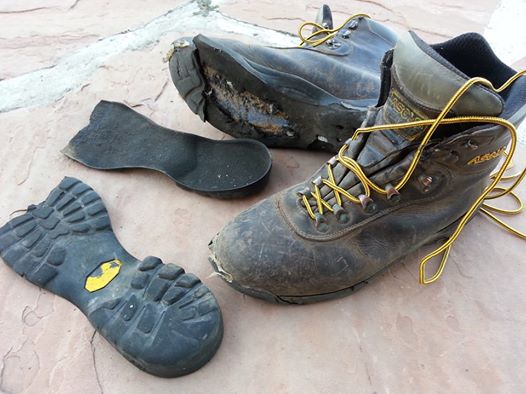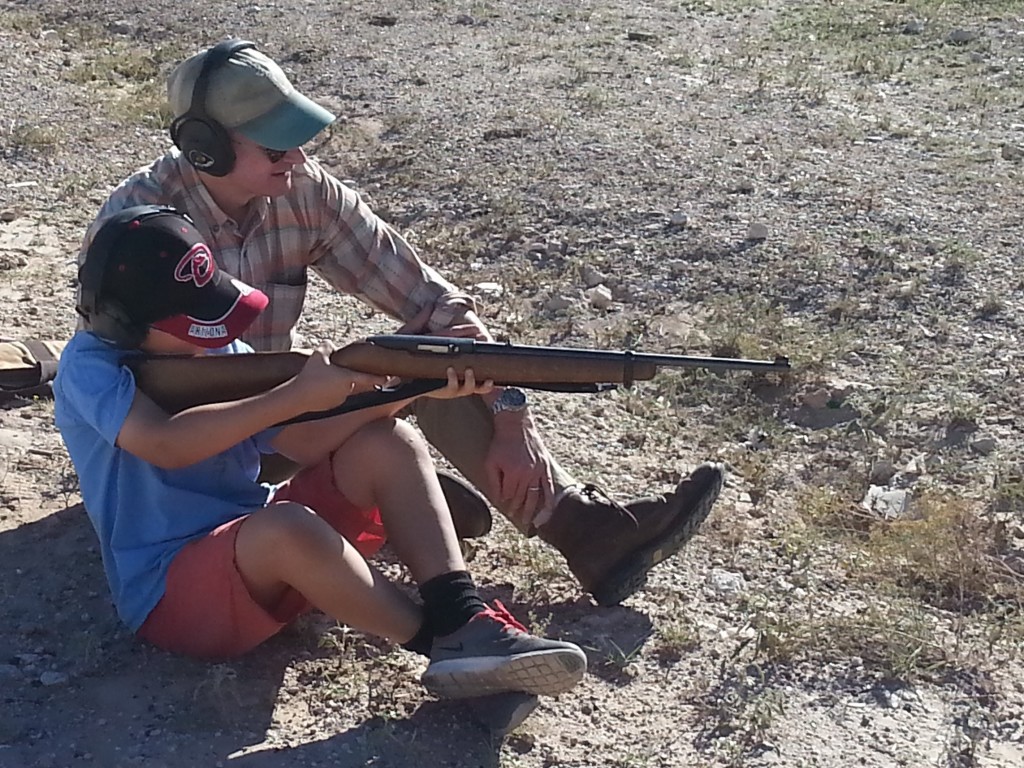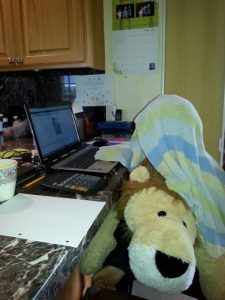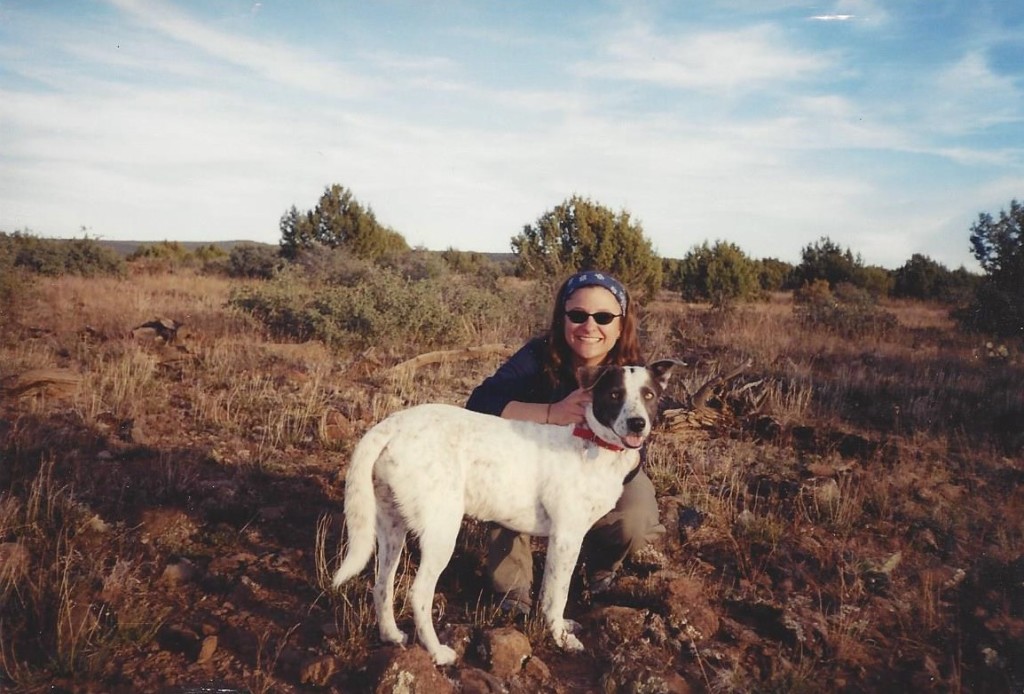 I miss my dog. He died almost a month ago, on Monday, September 26, 2016.
I miss my dog. He died almost a month ago, on Monday, September 26, 2016.
Wendy found Max wandering in the desert by the side of Beaverhead Flat Road–a road perhaps even less traveled in 2002 than it is now. He came trotting up to her car when she pulled over for a look at this scrawny, parched-looking dog in the middle of nowhere. She took him to the shelter, but they made it clear that they had limited resources.
“If nobody comes for him, will you take him?” they asked.
And we did. It was one of the better decisions we made.
Max made it clear that he liked people, and that he especially liked people who paid attention to him. When my father came to visit and sat on the sofa, our new dog jumped up next to him. Max flopped across his lap, lifted his leg, and issued a commanding groan.
“What does he want,” my father asked.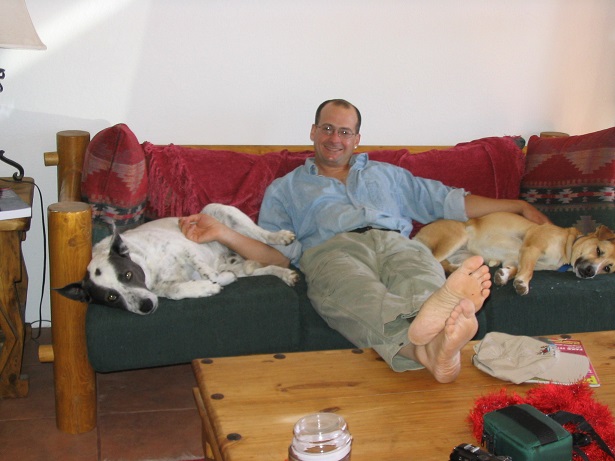
“A belly rub,” I answered. “So long as you’re going to sit there, he figures you might as well do something constructive.”
“Just so long as he doesn’t want a hand job,” my father answered, before obliging on the belly rub.
After a year or so, we decided that Max need some company. We adopted Sadie to be his playmate and in the hope that he might spend some time with her and a bit less time underfoot. Instead, affection became something of a competitive game; if I was petting one dog to my right, the other dog had to get equal treatment on my left. With the third hand, or something, I might actually turn the pages of a book.
Sadie never did quit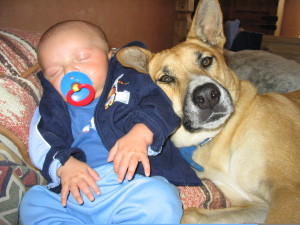 e fit in as well as Max. She spent a decade tormenting him (a true marriage, you might say)–and it took years before she seemed to decide that I just might be trustworthy. After she snapped at him, Max would often turn to me and seem to sigh. But they did disappear together for hours at a time to explore the neighborhood.
e fit in as well as Max. She spent a decade tormenting him (a true marriage, you might say)–and it took years before she seemed to decide that I just might be trustworthy. After she snapped at him, Max would often turn to me and seem to sigh. But they did disappear together for hours at a time to explore the neighborhood.
And Sadie did love Anthony–although she developed something of a sibling rivalry with him. She met him at the door everyday when he came back home from daycare. Showering him with Sadie kisses became a tradition.
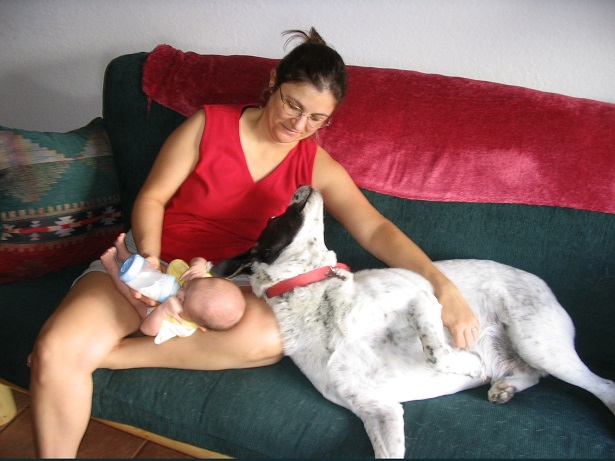 But when Anthony came along, it was Max who immediately became his protector. For every feeding, Max would drag himself across the house, accompanying whichever human adult was doing the honors at the moment. He kept strict watch for coyotes at all times–creatures for whom he had a life-time aversion, probably gained during his tenure on his own in the desert.
But when Anthony came along, it was Max who immediately became his protector. For every feeding, Max would drag himself across the house, accompanying whichever human adult was doing the honors at the moment. He kept strict watch for coyotes at all times–creatures for whom he had a life-time aversion, probably gained during his tenure on his own in the desert.
I distinctly remember one night when an already exhausted Max padded after my equally tuckered self across the dark house as I went to give the baby his bottle. Max flopped on the floor of Anthony’s room just as coyotes began howling in the distance. He began a low growl, which then tapered into a snore as he surrendered to the need to sleep.
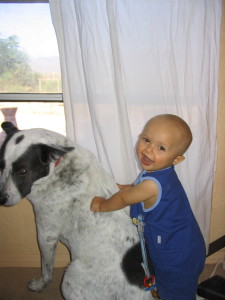 Early on, Max gained permission to sleep on the bed through the clever tactic of waking me every time he had a bad dream about coyotes, or heard thunder, or just felt lonely. He would stick his nose in my ear and whine until I calmed him–or, eventually, patted the bed to invite him up. This quickly became a permanent pass.
Early on, Max gained permission to sleep on the bed through the clever tactic of waking me every time he had a bad dream about coyotes, or heard thunder, or just felt lonely. He would stick his nose in my ear and whine until I calmed him–or, eventually, patted the bed to invite him up. This quickly became a permanent pass.
Once on the bed, he would slump on top of me, using me–as Snoopy did his dog house–like a bed. His head would go under my chin, and he’d promptly start snoring.
Yeah, I’m a sucker.
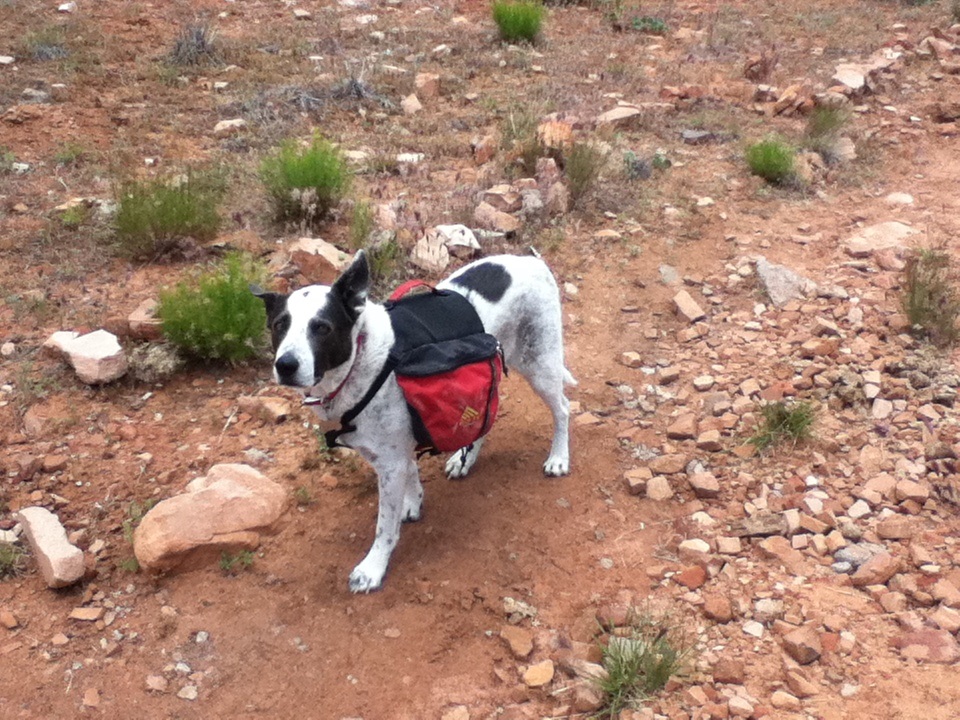 Max loved the outdoors and even had his own backpack for carrying snacks and his water bowl. It would go flapping in the air has he dove through the underbrush chasing rabbits or leaped from rock to rock in an arroyo. It was that enthusiasm that he felt and the joy that he so obviously wanted to share with us that I tried to infuse into “Champ,” his fictionalized self in the novel High Desert Barbecue.
Max loved the outdoors and even had his own backpack for carrying snacks and his water bowl. It would go flapping in the air has he dove through the underbrush chasing rabbits or leaped from rock to rock in an arroyo. It was that enthusiasm that he felt and the joy that he so obviously wanted to share with us that I tried to infuse into “Champ,” his fictionalized self in the novel High Desert Barbecue.
He and I went on our last backpacking trip together in 2011, while I was checking the accuracy of some of the descriptions I’d put into the book. He was beginning to get just a bit creaky for extended trips into the wilderness. We could’ve probably done one or two more, but I never did get them planned, and then it was too late.
 Max and I still went trail-running together, even after he survived a near-lethal encounter with a rattlesnake. He was tagged right between the eyes and I spent a week shuttling him to the vet, and then to an animal hospital, even as I was launching a new project for work.
Max and I still went trail-running together, even after he survived a near-lethal encounter with a rattlesnake. He was tagged right between the eyes and I spent a week shuttling him to the vet, and then to an animal hospital, even as I was launching a new project for work.
And then, a year after his rattlesnake encounter, he had his first bout with thyroid cancer. He recovered, but the cancer and the surgery knocked the stuffing out of him energy-wise. His body couldn’t quite live up to his intentions after that point.
We finally stopped running together because his knees were going. Not that he wasn’t the same Max. He still engaged rabbits in low-speed chases. And he still slept on the bed, though now he needed steps to make the climb. Maybe I wasn’t so comfortable anymore, since he started stretching out next to me instead of on top.
Sadie passed away last year, of an untreatable (except by radical surgery) sarcoma. While all of the human members of the household mourned, I don’t think it’s unfair to say that Max was almost indecently happy to have the place to himself, and to no longer have to worry about ambushes lurking around corners.
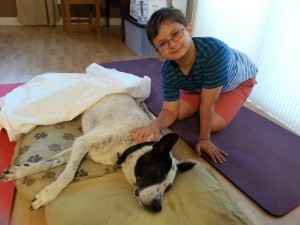 We were all with Max at the end, after the cancer returned. I spent two nights sleeping next to him on the floor while he refused food and most water. And then, on the last day, he somehow dragged himself to his feet. He made his way to the water bowl. He went outside to piss where he always did, on the small patch of grass in the back. He flopped for a while in his favorite resting spot under the dining room table. Then off to the front courtyard to watch the street through the gate. He even took a tiny nibble from my hand. I briefly allowed myself to hope that he was somehow getting better, but he staggered as he walked, and dragged his paws. You could see the stupendous physical effort he was expending to make what looked to me like a final grand tour of the things he loved to do. The cancer was still there, but so was his will and spirit, to the last.
We were all with Max at the end, after the cancer returned. I spent two nights sleeping next to him on the floor while he refused food and most water. And then, on the last day, he somehow dragged himself to his feet. He made his way to the water bowl. He went outside to piss where he always did, on the small patch of grass in the back. He flopped for a while in his favorite resting spot under the dining room table. Then off to the front courtyard to watch the street through the gate. He even took a tiny nibble from my hand. I briefly allowed myself to hope that he was somehow getting better, but he staggered as he walked, and dragged his paws. You could see the stupendous physical effort he was expending to make what looked to me like a final grand tour of the things he loved to do. The cancer was still there, but so was his will and spirit, to the last.
It was time for that final trip to the vet.
The Power of the Dog
by Rudyard Kipling
THERE is sorrow enough in the natural way
From men and women to fill our day;
And when we are certain of sorrow in store,
Why do we always arrange for more?
Brothers and sisters, I bid you beware
Of giving your heart to a dog to tear.
Buy a pup and your money will buy
Love unflinching that cannot lie
Perfect passion and worship fed
By a kick in the ribs or a pat on the head.
Nevertheless it is hardly fair
To risk your heart for a dog to tear.
When the fourteen years which Nature permits
Are closing in asthma, or tumour, or fits,
And the vet’s unspoken prescription runs
To lethal chambers or loaded guns,
Then you will find – it’s your own affair, –
But … you’ve given your heart to a dog to tear.
When the body that lived at your single will,
With its whimper of welcome, is stilled (how still!),
When the spirit that answered your every mood
Is gone – wherever it goes – for good,
You will discover how much you care,
And will give your heart to a dog to tear!
We’ve sorrow enough in the natural way,
When it comes to burying Christian clay.
Our loves are not given, but only lent,
At compound interest of cent per cent,
Though it is not always the case, I believe,
That the longer we’ve kept ’em, the more do we grieve;
For, when debts are payable, right or wrong,
A short-time loan is as bad as a long –
So why in – Heaven (before we are there)
Should we give our hearts to a dog to tear?
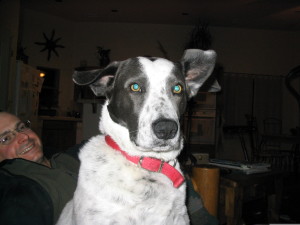
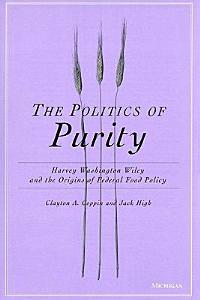


/public-media.smithsonianmag.com/filer/aa/79/aa795e05-84b8-4276-b156-6e5f6eb7c363/1024px-head_of_suffrage_parade_washington.jpg) How does a homeschooling lesson go? If done right, it sometimes wanders in unexpected directions.
How does a homeschooling lesson go? If done right, it sometimes wanders in unexpected directions.








